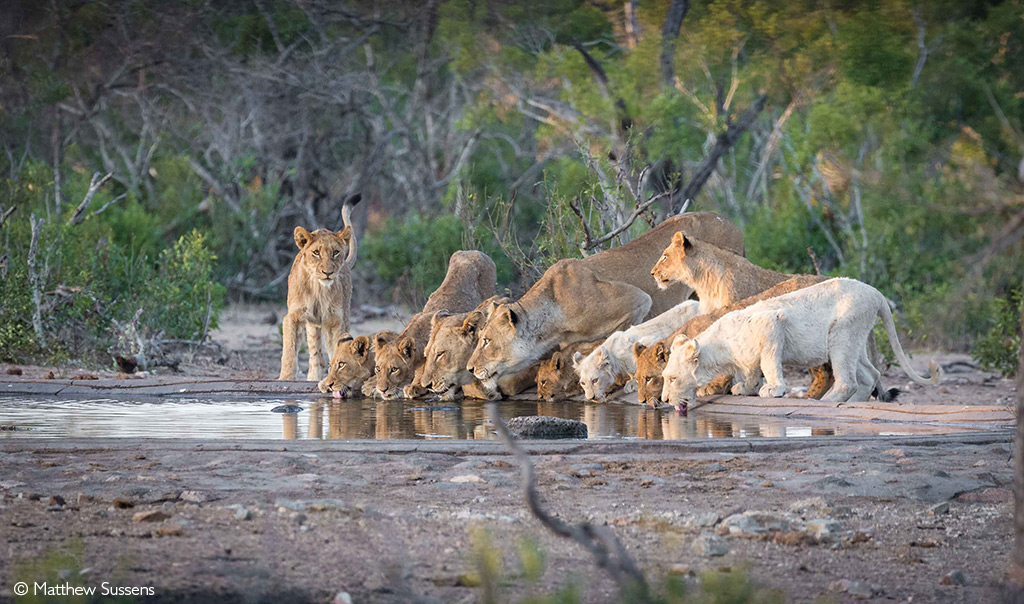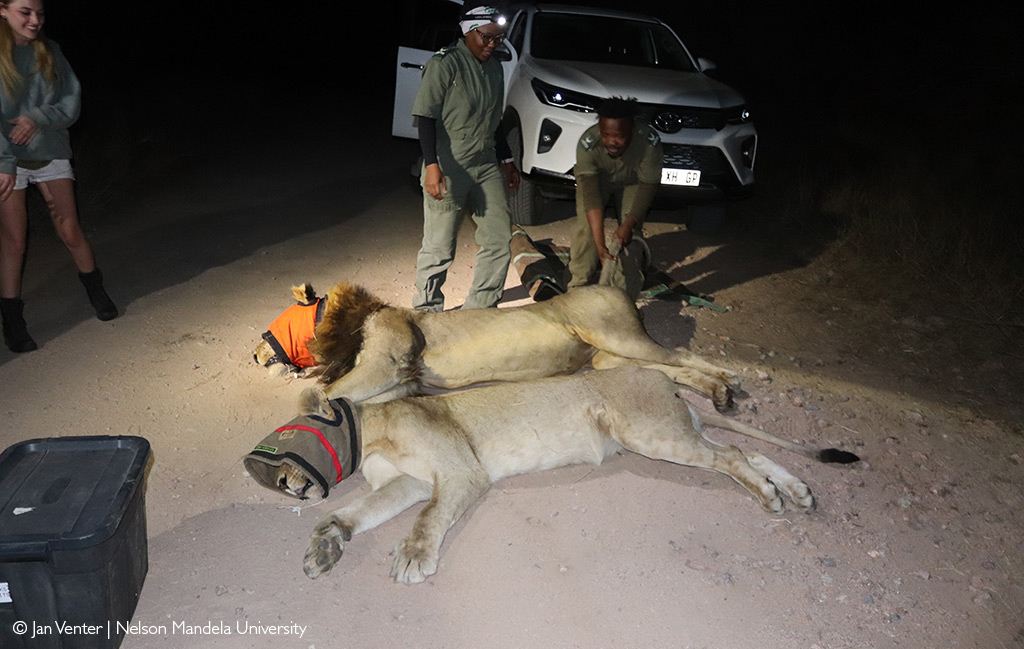 How does lion pride behaviour differ between fenced and open systems? Research teams monitoring lions in Kruger National Park, Pilanesberg National Park and Savé Valley Conservancy aim to find out. By collecting GPS, genetic-stress and behavioural data in a set of fenced reserves researchers are able to study how aggressiveness and territoriality regarding kinship between prides are affected by management practices.
How does lion pride behaviour differ between fenced and open systems? Research teams monitoring lions in Kruger National Park, Pilanesberg National Park and Savé Valley Conservancy aim to find out. By collecting GPS, genetic-stress and behavioural data in a set of fenced reserves researchers are able to study how aggressiveness and territoriality regarding kinship between prides are affected by management practices.
Are fenced lions happy? This is not as far-fetched a question as one might think. A lion has needs not dissimilar to humans – access to shelter, food, company, space and not too much stress. In lion terms, this would equate to issues around territory, prey availability, mates, and pride dynamics.
You may ask, what are the stresses that the king of the savannah faces? Aside, that is, from needing to fill his belly with antelope filet and finding a suitable spot in the sun to sleep it off? Nowadays, it boils down to the threats lions face, such as the consequences of human-wildlife conflict, habitat loss and decreased prey availability. These pressures are frequently ‘solved’ by fencing lions into protected areas. This often works well, as lion numbers tend to increase when protected. But what are the long-term effects on lions caused by fencing these wide-ranging creatures into closed areas?
What happens when lions are stuck in one place? Professor Jan Venter, his research team at Nelson Mandela University, the Southern African Conservation Trust and other project partners are working on this question in various reserves, including the Pilanesberg National Park and the Kruger National Park in South Africa. Of course, the answer is likely to be complex and knotty, as most conservation issues are, but it is relevant to the future of African lion populations.

Why do we want to know what happens to lions in reserves?
Lions used to roam freely across the great plains of Africa. With all its associated infrastructural and agricultural expansion, a burgeoning human population is putting more and more pressure on Africa’s wild spaces. The consequent increases in human-lion conflict and the need to keep human pressures off the land means that it is increasingly likely that protected areas will be fenced. Ideally, it would be great to find ways to integrate humans and wildlife across conservation areas, but we need to be realistic, too – this is not the answer for every landscape. If we want healthy ecosystem processes, we must protect some of the integrity of the last remaining ecosystems.
The African lion is listed as vulnerable on the IUCN Red List of threatened species, and its population has decreased by 75% in just five decades. In a nutshell, lions need protection, and this has played out as lions are increasingly confined to fenced reserves. Research shows that prides in fenced parks generally tend to have equal numbers of male and female lions, whereas those in more open areas have more females than males. In the more open landscapes, young males have space to disperse to start their pride, and this is an essential part of preventing inbreeding and keeping lion genetic diversity healthy. What happens when there is no space for more prides? The males stay at home. Ensuring genetic diversity requires a lot of intensive management in fenced reserves. Lion populations proliferate, and managers find it challenging to find new areas where young dispersing animals can be translocated. However, lions are unpredictable creatures, and sometimes, young males survive by staying in their pride. The question is – what then? Does the pride struggle to maintain integrity with competitive males? Do the closely packed prides get more or less territorial and aggressive with their neighbours? And what if those neighbours are closely related (as would happen in a closed area)? Or do they get stressed because they are living right next door to their mother-in-law, so to speak?
How to find the answers
Before one can understand lion behaviour in these situations, one first needs to find out how many lions are in the selected reserves and which lions are in each pride. Counting lions is not as easy as one might think. Besides the manes, they tend to look alike and move about. If reserves don’t have a person dedicated to lion monitoring, and many don’t because of the expense, they can quickly lose count of their lions. This is why the researchers decided to go into Pilanesberg National Park and work out the minimum sampling method needed to keep track of lion numbers. Their strategy was simple: drive along the roads, and photograph and count lions. Using spatially explicit count-recount methods, they did 7,000km of surveys by road and discovered that 4,000km was the minimum sampling level needed for the model to perform well. They estimated that there are 8,8 lions per 100km2, which was lower than anticipated by park management.
However, not all parks contain a network of roads, so the team are also investigating different options to count lions. This is a bit like attempting a puzzle with some missing pieces. To accurately identify different individual lions (so you don’t count the same lion twice), you need to find recognisable and discernible features on the lions. The researchers used lion whisker patterns. This means they needed to take up close and personal images of the whiskers. On lions’ faces. In fine detail… So, if driving to take high-definition photos is not an option, one will need high-quality remote cameras in the survey area. The logistics are the fly in the ointment here – remote cameras need a cellphone signal to download the data and battery solutions, are exposed to theft, and are costly. It’s a project in progress.


Currently, the team is busy counting lions in the Kruger National Park in South Africa, an area of nearly 2 million hectares. Considered a more open system, Kruger is being used as a control reference to which the closed/fenced systems can be compared. But counting lions in a vast area like Kruger presents its unique challenges: Kruger is a very large space – creating a challenge for those trying to find tawny bodies lolling in lion-coloured grass. The team is using the same methodology to count lions used in the Pilanesberg (Bayesian Spatial Capture-Recapture methods). Hopefully, in a few months, the team will have a lion headcount, with robust statistical confidence in these numbers. They will also undertake lion counts later in the year in the Savé Valley Conservancy in Zimbabwe, and other reserves. They will then put GPS collars on a lion from each of about 20 prides and use the data to answer applied management questions.

What will be measured?
Study team coordinatior Prof Jan Venter (the team coordinator) hopes to find out what adjacent or neighbouring prides do in closed, confined reserves – and how they interact. Usually, when the male lions in a litter grow to a certain age, they leave because the older, dominant male pushes them out, and then they disperse, usually to other places where they are safe from these dominant males. So far, the collar data, although not scientifically analysed yet, shows that prides might become unstable in confined spaces. Some preliminary data shows that the lion territories shift spatially, and prides split up and restructure very differently.
 You can help in this important study by sponsoring a collar in full or by donating any amount—large or small—to support this critical conservation project. These collars collect GPS, genetic stress, and behavioural data. Learn more here.
You can help in this important study by sponsoring a collar in full or by donating any amount—large or small—to support this critical conservation project. These collars collect GPS, genetic stress, and behavioural data. Learn more here.
So, how do we know if these pride shifts stress them? Does fenced-area management effectively protect declining lion populations’ resilience? It is vital to know how the dynamic shifts of prides might influence their stress levels. The fenced lions might not be facing human aggression or stressors, but they might be under more pressure from prides that are operating in close proximity to one another. They might be facing more aggression from their own species.

To answer this, the lion GPS collars will have accelerometers, which measure speed and direction of movement. The team might be able to work out lions’ energy budgets, how much the animals are moving, and how much effort they are putting into this. Movement data can tell you, for example, whether a large pride, which is a stronger pride, is infringing on the territory of a small pride. They will also measure cortisol levels to test the lions’ stress levels.
To test whether lions might be more tolerant of infringing prides if the lions are closely related, they will be taking blood samples to identify levels of relatedness. In addition, they will use playback experiments to test the reactions of lions to calls from related versus non-related prides. This involves playing lion-territorial calls back to lions. Once a playback is applied, researchers will record how the lions react to the playback. They may respond aggressively, and head towards the sound. Or they can react by running away. Or, they could remain indifferent – lying around, not reacting, and simply twitching an ear. Some of the possible predictions are that they should be less aggressive if they are all more related. If one pride is stronger, they are likely to be more aggressive than a pride that is not as confident and strong.
All’s fair in lion love and war
Lions are territorial, and fight to defend their territories. They may be red in tooth and claw, but how might these social felines react to prides that are close in kin? And do they perform differently in fenced reserves? In natural, open areas, new males joining a pride will often kill young cubs, to make sure lionesses go into oestrus sooner. What changes in fenced areas? And do fences hamper the resilience of lions? Watch this space to hear more about what the researchers find.

Further lion reading
1. Lions are under threat. Read more about the fragility of lion populations in Africa, probing socio-political & ecological factors
2. Research shows that lion populations across the continent have declined by 75% in just five decades. Read more about Africa’s vanishing lions here.
Reference
Ball, Isabella & Marneweck, David & Elliot, Nicholas & Gopalaswamy, Arjun & Fritz, Hervé & Venter, Jan. (2023). Considerations on effort, precision and accuracy for long‐term monitoring of African lions ( Panthera leo ), when using Bayesian spatial explicit capture–recapture models, in fenced protected areas. Ecology and Evolution. 13. 10.1002/ece3.10291.
To comment on this story: Login (or sign up) to our app here - it's a troll-free safe place 🙂.![]()






